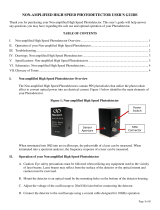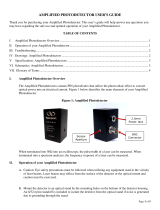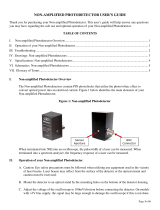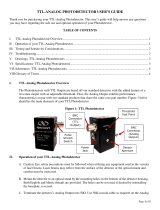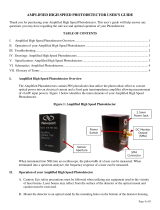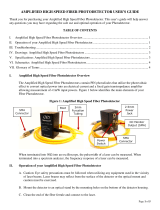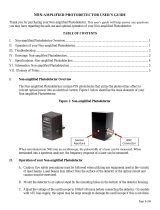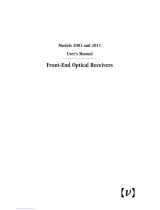Page is loading ...

Page 1 of 5
HIGH SPEED FIBER PHOTODETECTOR USER’S GUIDE
Thank you for purchasing your High Speed Fiber Photodetector. This user’s guide will help answer any
questions you may have regarding the safe use and optimal operation of your Photodetector.
TABLE OF CONTENTS
I. High Speed Fiber Photodetector Overview ..................................................................................................... 1
II. Operation of your High Speed Fiber Photodetector ........................................................................................ 1
III. Troubleshooting ............................................................................................................................................... 2
IV. Drawings: High Speed Fiber Photodetectors ................................................................................................... 3
V. Specifications: High Speed Fiber Photodetectors ........................................................................................... 3
VI. Schematics: High Speed Fiber Photodetectors ................................................................................................ 4
VII. Glossary of Terms .......................................................................................................................................... 5
I. High Speed Fiber Photodetector Overview
The High Speed Fiber Photodetectors contain PIN photodiodes that utilize the photovoltaic effect to
convert optical power into an electrical current. Figure 1 below identifies the main elements of your
Fiber Photodetector.
Figure 1: High Speed Fiber Photodetector
When terminated into 50Ω into an oscilloscope, the pulsewidth of a laser can be measured. When
terminated into a spectrum analyzer, the frequency response of a laser can be measured.
II. Operation of your High Speed Fiber Photodetector
A. Caution: Eye safety precautions must be followed when utilizing any equipment used in the vicinity
of laser beams. Laser beams may reflect from the surface of the detector or the optical mount and
caution must be exercised.
B. Clean the end of the fiber ferrule and connect to the laser.
C. Adjust the voltage of the oscilloscope to 50mV/division before connecting the detector.
Power
Switch
3mm
Furcation
Tubing
Boot
SMA
Connector

Page 2 of 5
D. Connect the detector to the oscilloscope using a coaxial cable designed for 10GHz operation.
E. Use the 50Ω termination input of the oscilloscope.
F. After being certain that the damage threshold of the detector is not exceeded, turn on the laser.
G. There is an internal 50Ω resistor at the output of the photodiode. This will cause the output current to
your test equipment to be half that of the photodiode output. For example, the output to your
equipment will be 450µA for a 1mW optical input at 0.9A/W. Some losses will also exist in the fiber
cable and connectors.
III. Troubleshooting
A. No signal is seen the first time the detector is used.
1. Is the power switch on?
2. Be certain that the signal is not high off scale on the oscilloscope.
3. Is the wavelength of the laser within the spectral range of the detector?
4. Has a 50Ω termination input been used?
5. Make sure the fiber radius is greater than 1 inch. Inspect fiber for damage.
6. Is there enough light (see sensitivity spec on the data sheet) incident on the detector to generate a
signal?
B. A signal has been previously obtained, but not currently.
1. Try steps listed under A.
2. Test the power supply:
a. Units with internal batteries will typically operate for several years, but operation with CW
or high rep rate lasers can drain the batteries much faster. If a load is present at the output,
current will be drawn from the batteries, so disconnect the BNC when not in use.
Remove top cover to replace the 3V lithium cells with Duracell Model DL2430, positive side
down.
b. Units with an external power supply should at least receive the voltage that is printed on the
plug.
C. Increasing the power incident on the detector does not result in a higher voltage signal on the
oscilloscope:
1. The detector is probably saturated. You should lower the power incident on the detector to a
level below the saturation point.

Page 3 of 5
IV. Drawings: High Speed Fiber Photodetectors
A. 818-BB-35F, 818-BB-45F, 818-BB-51F Dimensions:
V. Specifications: High Speed Fiber Photodetectors
Part No. (Model) - Battery Bias
818-BB-35F
818-BB-45F 818-BB-51F
Rise Time/Fall Time (ps)
<25/<25 <30/<30 28
Responsivity (A/W)
>0.65 at 1300nm 0.38 at 830nm 0.95 at 2000nm
Power Supply
6V battery/5V external 3V battery/5V external 3V battery/5V external
Spectral Range (nm)
830-1650 500-890 830-2150
Bandwidth
>15GHz >12.5GHz >12.5GHz
Active Area Diameter (µm)
32 60 40
Dark Current
<3nA <0.5nA <1µA
Noise Equivalent Power (pW/√Hz)
<0.05 at 1300nm <0.03 at 830nm <0.6 at 2000nm
Mounting (Tapped Hole)
8-32 or M4 8-32 or M4 8-32 or M4
Output Connector
SMA SMA SMA
Fiber Optic Connection
FC/UPC, SMF 28e FC/UPC, SMF 28e FC/UPC

Page 4 of 5
VI. Schematics: High Speed Fiber Photodetectors

Page 5 of 5
VII. Glossary of Terms
Bandwidth: The range of frequencies from 0Hz (DC) to the frequency at which the amplitude decreases
by 3dB. Bandwidth and rise time can be approximately related by the equation:
Bandwidth ≈ 0.35/rise time for a Gaussian pulse input.
Bias Voltage: The photodiode’s junction capacitance can be modified by applying a reverse voltage.
The bias voltage reduces the junction capacitance, which causes the photodiode to have a faster
response.
Dark Current: When a termination is present, a dark current (nA range) will flow if the photodiode is
biased. Disconnecting the coaxial cable will prevent this current from flowing.
Decoupling Capacitor: Maintains bias voltage when fast pulses cause the battery voltage to reduce (this
would slow the response time of the photodiode); the capacitor allows the battery to recover to its initial
voltage. It also acts as a filter for external power supplies.
Noise Equivalent Power (NEP): A function of responsivity and dark current and is the minimum
optical power needed for an output signal to noise ratio of 1. Dark current is the current that flows
through a reverse biased photodiode even when light is not present, and is typically on the order of nA.
Shot noise (Ishot) is a source of noise generated in part by dark current; in the case of reversed biased
diodes it is the dominant contributor. NEP is calculated from shot noise and responsivity. For example,
for a responsivity @ 830nm = 0.5 A/W:
q = charge on an electron
Photodiode: Converts photons into a photocurrent.
Resistor: Protects the photodiode from excessive current. This could occur if an external power supply
was too high in voltage, or if its polarity were reversed; this happens when a customer uses their own
power supply.
Responsivity: In amps per watt (A/W), responsivity is the current output of the photodiode for a given
input power, and is determined by the diode structure. Responsivity varies with wavelength and diode
material.
Rise time/Fall time: Rise Time is the time taken by a signal to change from a specified low value to a
specified high value. Fall Time is the time taken for the amplitude of a pulse to decrease from a
specified value to another specified value. A larger junction capacitance will slow the detector’s
response time.
SMA Connector: Used to connect the customer’s coaxial cable for high frequencies.
Termination Resistor (50Ω): Reduces signal reflections and balances the 50Ω microstrip/coaxial cable
lines. As a result, half the photodiode current is lost to the internal resistor.
Hz0.08pA/s0.08pA)1020)(2(1.6x10=2_
9-19
===
−
AxAsqINoiseShot
d
Hz0.16pW/
0.5A
W
*
08.0
/R
830nm
===
Hz
pA
INEP
shot
1/5
